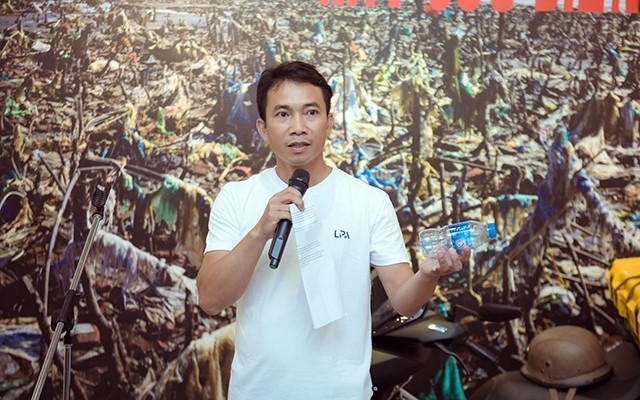With a motorbike and other equipment, Lekima Hung traveled along 3,000km of coastline in 28 provinces and cities and more than 100 estuaries. Through the exhibition, the photographer expressed his meaningful stories and concerns about the marine environment.
Lekima Hung, who was born in 1977 in Hanoi, was a former student at the National Economics University. His nickname was derived from the memory of the le ki ma (pouteria lucuma) flowers in the childhood.
The exhibits, selected from 3,000 photos, were arranged according to the contents, locations and the time. This has helped viewers easily envisage the overall situation of plastic waste on the coastlines of the country. Talking about the inspirations and ideas behind the collection, Lekima Hung said, five years ago, his mother had found out she had cancer. A doctor said the origin of her disease was the influence of micro-plastic particles. He found out all the relevant information via the internet and was surprised to know that Vietnam was listed among the countries ranked high on ocean plastic waste pollution. Being a photographer and photography teacher, he believed that the informational and emotional values of each photos will change the perception and actions of the community, so he decided to travel.
During his journey to capture the image of marine plastic waste, Lekima Hung approached many issues. For example, plastic wastes were floating in several canals along Tuy Phong beach, Binh Thuan province so much so that it is even difficult to see the water. Meanwhile, many children played in the toxic environment. Similarly, many long beaches have become garbage dumps. Hung captured the moment when people threw rubbish to the beaches as if they were doing their morning exercise while expressionless. They burned garbage right at the dump with numerous reasons such as they had no dustbin, causing the fire of trees around.
Lekima Hung shared: “Through the exhibition, I aim to help people imagine what is happening and what the consequences will be if they do not protect and improve the environment. I also wish that my stories would be spread and strongly inspire the community, contributing to changing the awareness and promoting positive actions and greater attention from the ministries and agencies in the fight against plastic waste”.
The exhibition “Save our sea” also attracted many foreign visitors and artists. Lekima Hung said his photo stories about waste are not poetic but they were true and painful stories. He believed that the exhibition will be useful because all people find themselves.
There were many special spectators. Engineer Tran Vu Thanh, who chaired projects of filtering saltwater into fresh water and garbage compactors on the rigs in Truong Sa (Spratly) island, was also a photography enthusiast. He said that the problem of waste is insolvable not only on the mainland but also n the remote islands. The rubbish floating on the sea and drifting on the island are following the waves. Soldiers on the island have to collect and smash up plastic waste and put them into sacks and then load them onto ships to transport them to the mainland for handling. In Truong Sa island, all plastic cans are strictly controlled. In addition to the waste that can be recycled into pots, pen boxes and souvenirs, other types of garbage are smashed up. Despite difficult conditions, soldiers in the remote island have joined their hands to protect the environment by all means. Lekima Hung also went to Truong Sa island, so he hoped that from taking practical actions, the big story on garbage, particularly marine plastic waste can be solved.
















